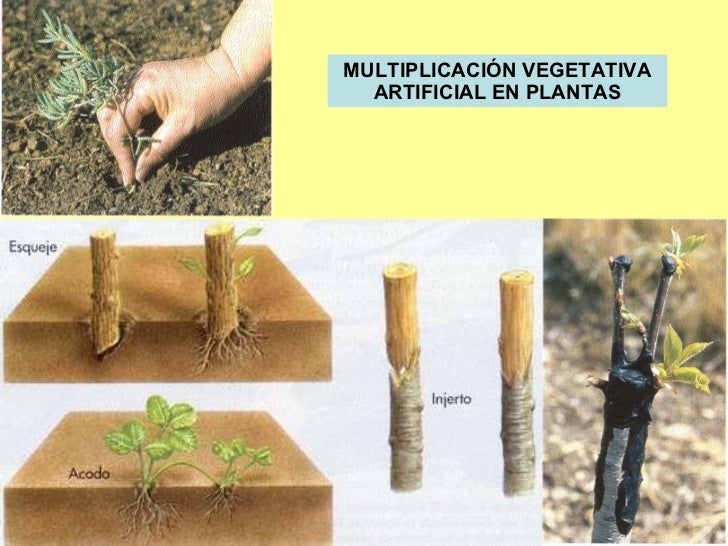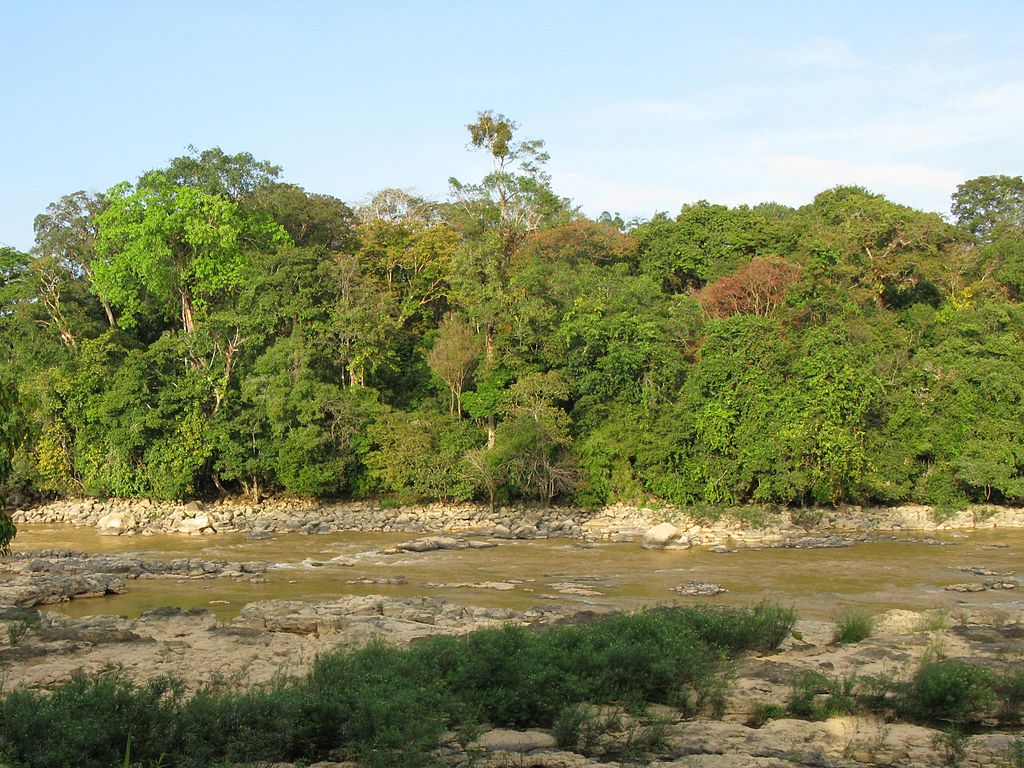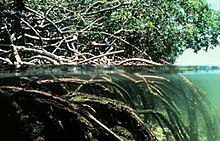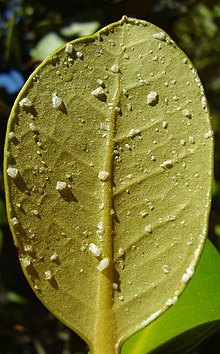Es la producción de un nuevo organismo a partir de un fragmento del propio organismo, que pueden ser porciones de tallo y hojas (unidad reproductora). Este potencial de regeneración se ha explotado históricamente por el hombre de forma natural en correspondencia con a la multiplicación vegetativa. A partir de los principios de la mitosis y la totipotencia de la célula vegetal se sustentó la multiplicación vegetativa artificial.
Formas de la multiplicación vegetativa:
Natural
Producción de un nuevo organismo a partir de un fragmento del propio organismo, que pueden ser porciones de tallo y hoja. Este potencial de regeneración se ha explotado históricamente por el hombre de forma natural en correspondencia con a la multiplicación vegetativa natural, a partir de los órganos metamorfoseados utilizando la presencia de las yemas, que son; tuberculosis, bulbos,estolones,rizomas.

Artificial
A partir de los principios de la mitosis y la totipotencia de la célula vegetal se sustentó la multiplicación vegetativa artificial, que recurre a tallos no metamorfoseados en este tipo de técnica; se utilizan las yemas de los nudos y se aplican diferentes artificios, por medio de los cuales se propagan las plantas por multiplicación vegetativa artificial.
Entre las que podemos citar: estacas, acodo, margullo, injertos y que es un caso especial. También se incluyen las técnicas de cultivo de tejidos invitro. Es de destacar que siempre que se utilicen estos tipos de propagaciones vegetativas, los individuos obtenidos serán idénticos a la planta madre. Los individuos obtenidos de semillas producto del proceso de fecundación como resultado de la reproducción sexual, están sujeto a las leyes de la herencia como consecuencia de la variabilidad genética.

Partes utilizadas en la propagación vegetativa natural
Tubérculo
Es un tallo subterráneo de tipo geófito, se caracteriza por su crecimiento anómalo, ya que forma las yemas; gran cantidad de tejido parénquima de reserva y un fino tejido suberoso. Se mantienen como huellas de los tallos, sin presencia de raíces. Pasado un tiempo de manera espontánea y condiciones adecuadas, se pueden originar nuevas plantas. En la actualidad se cosechan los tubérculos; unos se comercializan y otros se utilizan en la propagación vegetativa, para mantener la variedad deseada de papa.
Bulbo
El bulbo consta de un disco o platillo, donde se localizan las yemas cubiertas por catáfilos de hojas. Esto le permite originar nuevas plantas por este tipo de reproducción. Las especies son ajo, gladiolo.
Estolón
Es una rama lateral de crecimiento horizontal, con nudos que forman raíces en la parte ventral y hojas en el dorso, se cortan de tramo en tramo donde aparecen las raíces, se eliminan las hojas y se siembran. Se utilizan en la fresa, pangola, violeta.
Retoño, hijo o vástagos
Este tipo de multiplicación vegetativa natural, se aprovecha en la agricultura, a partir de los rizomas, que producen en sus yemas, vástagos, retoños e hijos. Este tipo de propagación se aplica mucho en especies tales como; plátano, mariposa y piña . A esta variante de propagación se le llama retoños o hijos, entre productores.

Partes utilizadas en la multiplicación vegetativa artificial
Otros tallos no metamorfoseados se utilizan en la multiplicación vegetativa artificial, se recurre a las yemas de los tallos, se elaboran estacas y acodos. En los injertos se utiliza el cambio vascular para lograr el efecto deseado.
Estacas
El ingenio del hombre permitió, utilizar la capacidad de muchas plantas de regenerarse y poder formar un punto vegetativo caulinar o radical en las zonas de cicatrización. Así, logran unidades reproductoras a partir de las estaca, tanto de pedazos de tallos como de hojas, que colocadas en condiciones favorables son capaces de formar un nuevo individuo con caracteres iguales a la planta madre. Las estacas se usan ampliamente en horticultura y jardinería. Se utilizan soluciones de fitohormonas, que aceleran el enraizamiento de las mismas.
Entre las especies de plantas que se propagan por trozos de tallos provistos de yemas cuya configuración responde a los patrones generales de los tallos aéreos estudiados, se pueden citar; la caña de azúcar, yuca, cacao, rosales, marpacífico y croton.
Las hojas de muchas especies pueden desarrollar también puntos de crecimientos por la actuación de los meristemos, como son: las begonias , violeta africana y siempreviva.
Acodo
Esta técnica tiene dos variantes acodo de tierra y acodo aéreo se realizan sobre las ramas de las plantas. El acodo de tierra, se toma una rama de la planta madre deseada, se hacen cortaduras de forma tal que llegue a los meristemos, se dobla la rama y obligándola a tocar suelo y acto seguido, se cubre con tierra, al enraizar el área, se obtienen una unidad reproductora, se siembran y se obtiene una nueva planta igual a la progenitora.
Para el acodo aéreo, se realizan cortaduras en distintas ramas, terminadas las cortaduras, se rodean las zonas con tierra y material adecuado y se sujeta con polietileno, yute u otro material idóneo para logar el enraizamiento, cuando surge el enraizamiento, se corta de la rama y se siembra la unidad reproductora.
Injerto
Se entiende por injerto, al traslado de una yema a la rama de una planta (patrón), donde ésta se inserta y se ata para fijarla y asegurar la concrescencia de los tejido que deben quedar unidos al prender el injerto hecho. Para lograr los injertos, se debe tener en cuenta:
- Las especies deben ser afines por lo general no es posible injertar individuos de especies distintas, no obstante, existen excepciones como los géneros: Citrus y Rosa.
- Hay que colocar el injerto en posición normal, de acuerdo a las leyes de la polaridad. Sí se invierten, no desarrollará el brote de la yema injertada.
- El injerto solo puede realizarse en plantas que posean cambio vascular, para que sea posible la adherencia de los tejidos.
- Existe una influencia reciproca entre el patrón y el injerto, pero no es tema a debatir.
- Las especies de rosales y muchos frutales no producen semilla cuando se propagan por este medio.
- Son variados los tipos de injertos que se practican: aproximación,escudete, de corona y púa. Esto será tema medular en Fitotecnia.












